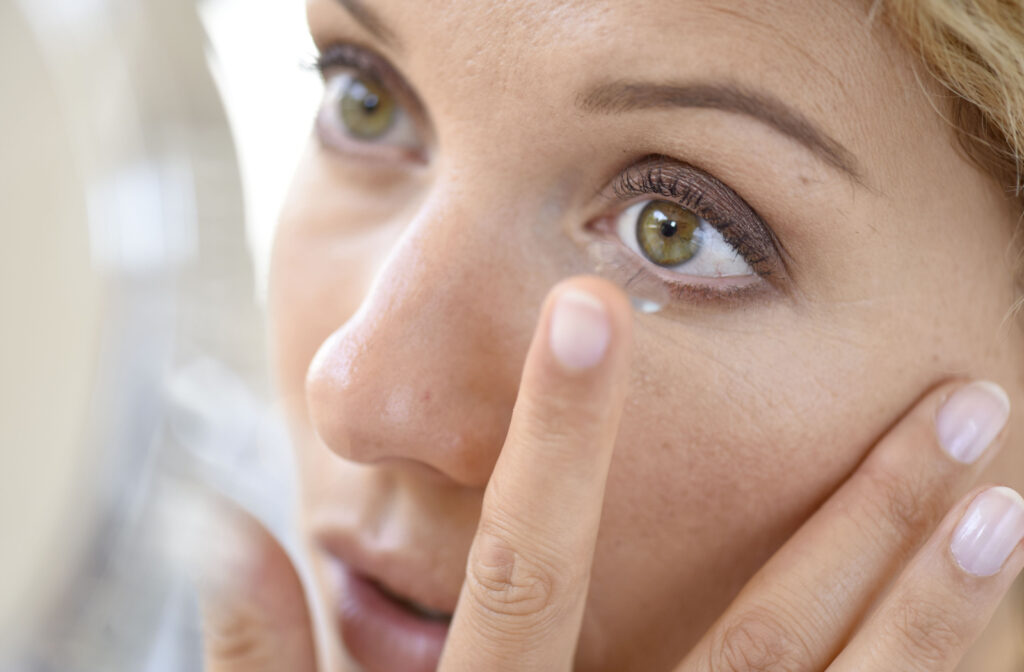Contact lenses are becoming more popular as people look for an alternative to traditional eyewear, with about 45 million Americans wearing contact lenses today. While many people find them comfortable and convenient, those with dry eyes might wonder if they can wear contacts despite the burning, grittiness, and redness.
The answer is yes! Specialty contact lenses are made to address a variety of specific eye conditions, including dry eyes. In fact, scleral contact lenses can provide vision correction while potentially fixing irritating dry eye symptoms.
Living with Dry Eye
Dry eye occurs when the eyes don’t produce enough tears or produce poor-quality tears that evaporate too quickly. This lack of tears can cause a bunch of irritating symptoms, such as:
- Grittiness
- Burning
- Scratchiness
- Blurred vision
- Light sensitivity
- Excessive tearing (the eyes may try to compensate for the lack of moisture)
In many cases, dry eye is simply a result of getting older. As we age, our tear production decreases, leading to dry eyes. But this isn’t the only risk factor—dry eye can affect anyone. Some people may only get dry eyes occasionally, while others live with chronic dry eye every day.
Reasons you may develop dry eye include:
- Certain medications, such as antihistamines or decongestants
- Medical conditions like Sjögren’s syndrome
- Dry air, wind, or high temperatures
- Not blinking enough, especially while working on a computer
What Are Scleral Lenses?
Scleral lenses are made from gas-permeable material and have a larger diameter than traditional contact lenses. Non-scleral contacts are about 9–9.5 mm. However, scleral lenses can range from mini-sclerals, at 14.5 mm, up to an impressive 24 mm! That’s over double the size of the average contact lens.
Scleral lenses have the same advantages other rigid gas-permeable lenses do over soft contacts, such as:
- Greater visual acuity
- Easier to handle
- More durable
But, because of their size, scleral lenses are also generally more stable on the eye, so you’re less likely to dislodge them throughout your day. Some people also find they’re easier to adjust to, with greater initial comfort.
How Do Scleral Lenses Address Dry Eye?
A traditional contact lens sits directly on the cornea, the clear dome at the front of your eye. However, the larger design of scleral lenses enables them to create a pocket of space between your cornea and the lens, allowing a fluid reservoir to sit against your eye and help keep it moisturized.
Since scleral lenses offer the sharp vision of gas-permeable lenses, wearers don’t have to choose between vision correction and comfort. In one study, patients said they found scleral lenses more comfortable, improved their vision, and reduced the need for hydrating eye drops.
Another benefit of scleral lenses is you can use them with other dry eye treatments. For example, let’s say you use eye drops or brushes to clear the blockages from your eyelids. Scleral lenses can be worn in addition to these treatments, providing extra moisture and eye protection.
Can I Wear Contact Lenses with Astigmatism?

While dry eye is a frustrating and common condition, it’s not the only one that may prevent you from wearing contact lenses. Thankfully, advances in lens technology have allowed more people to correct their vision. So, let’s look at another reason you may have trouble finding contacts.
Astigmatism is a common eye condition that used to be notorious for being “hard to fit” for contact lenses. It occurs when the cornea is slightly misshapen, affecting how light focuses as it enters the eye. While optometrists commonly prescribe glasses to correct astigmatism, they’re not the only option.
3 types of contact lenses are typically recommended to correct astigmatism:
- Gas-permeable lenses
- Toric lenses
- Hybrid lenses
Gas-Permeable Lenses
Gas-permeable lenses are rigid enough not to attempt to conform to an irregular cornea. They let oxygen pass through to the eye and include scleral lenses. What’s more, scleral lenses vault over the cornea entirely and may provide excellent correction despite an uneven surface.
Toric Lenses
Toric lenses, on the other hand, are soft. They’re designed to sit on your eye in a specific orientation, gently “turning” as you wear them until they’re at the perfect angle. Naturally, this means they can be harder to fit, and it could potentially take longer to find the right pair.
Hybrid Lenses
Hybrid lenses get the best of both worlds. The center is rigid and gas-permeable, offering sharp vision and stability. The outside ring is soft and gentle on your eyes, giving you comfort. Hybrid lenses are a good option for those with astigmatism or sensitive eyes who can’t tolerate RGP lenses.
Talk to your optometrist if you have any of the following eye conditions, and you may be surprised to learn that contact lenses could still be an option:
- Keratoconus
- Presbyopia
- Dry eye
- Astigmatism
- Post-laser surgery complications
Clear Vision & Comfort
If you suffer from dry eyes and are looking for a solution that will allow you to wear contacts comfortably, consider scleral lenses. Many people think they have no hope of ever wearing contacts comfortably. But it doesn’t have to be that way.Our team at Vision Therapy Institute has brought relief to people who thought their options had run out. So don’t let dry eye hold you back from living your life. Book an appointment and ask about scleral lenses. Your eyes will thank you for it!





